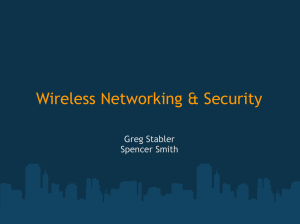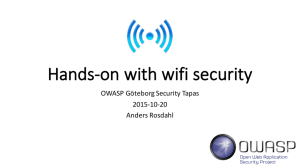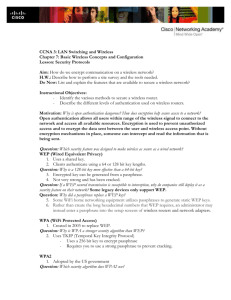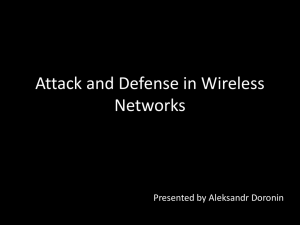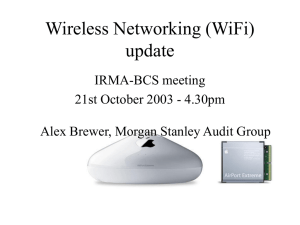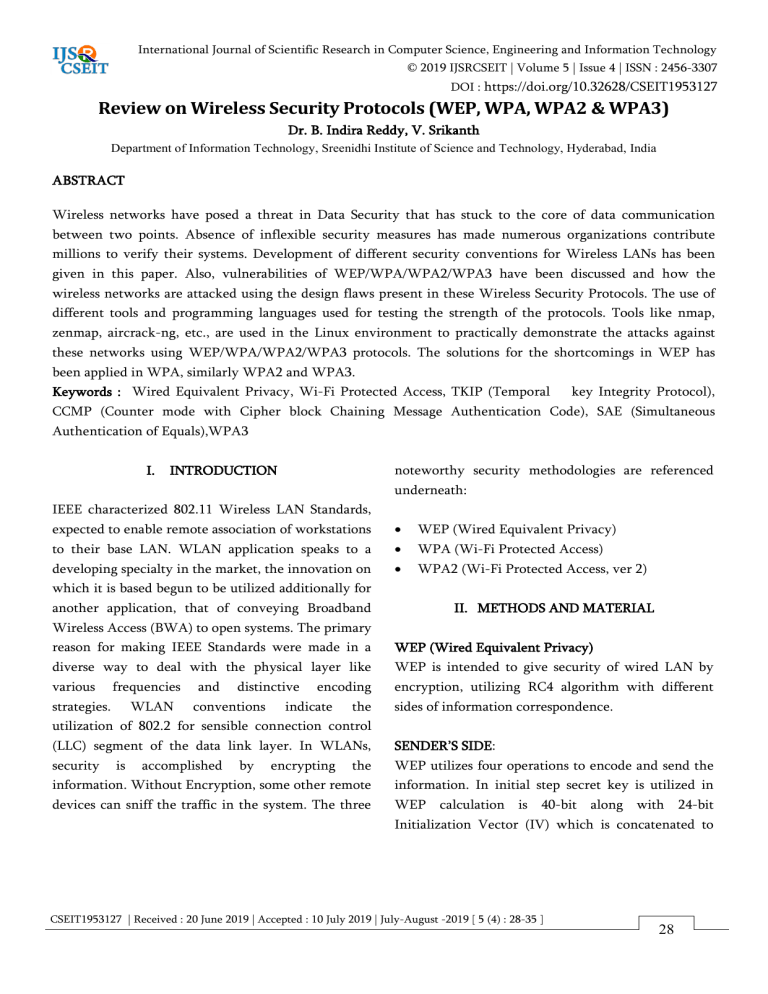
International Journal of Scientific Research in Computer Science, Engineering and Information Technology © 2019 IJSRCSEIT | Volume 5 | Issue 4 | ISSN : 2456-3307 DOI : https://doi.org/10.32628/CSEIT1953127 Review on Wireless Security Protocols (WEP, WPA, WPA2 & WPA3) Dr. B. Indira Reddy, V. Srikanth Department of Information Technology, Sreenidhi Institute of Science and Technology, Hyderabad, India ABSTRACT Wireless networks have posed a threat in Data Security that has stuck to the core of data communication between two points. Absence of inflexible security measures has made numerous organizations contribute millions to verify their systems. Development of different security conventions for Wireless LANs has been given in this paper. Also, vulnerabilities of WEP/WPA/WPA2/WPA3 have been discussed and how the wireless networks are attacked using the design flaws present in these Wireless Security Protocols. The use of different tools and programming languages used for testing the strength of the protocols. Tools like nmap, zenmap, aircrack-ng, etc., are used in the Linux environment to practically demonstrate the attacks against these networks using WEP/WPA/WPA2/WPA3 protocols. The solutions for the shortcomings in WEP has been applied in WPA, similarly WPA2 and WPA3. Keywords : Wired Equivalent Privacy, Wi-Fi Protected Access, TKIP (Temporal key Integrity Protocol), CCMP (Counter mode with Cipher block Chaining Message Authentication Code), SAE (Simultaneous Authentication of Equals),WPA3 I. INTRODUCTION noteworthy security methodologies are referenced underneath: IEEE characterized 802.11 Wireless LAN Standards, expected to enable remote association of workstations • WEP (Wired Equivalent Privacy) to their base LAN. WLAN application speaks to a • WPA (Wi-Fi Protected Access) developing specialty in the market, the innovation on • WPA2 (Wi-Fi Protected Access, ver 2) which it is based begun to be utilized additionally for another application, that of conveying Broadband II. METHODS AND MATERIAL Wireless Access (BWA) to open systems. The primary reason for making IEEE Standards were made in a WEP (Wired Equivalent Privacy) diverse way to deal with the physical layer like WEP is intended to give security of wired LAN by various encryption, utilizing RC4 algorithm with different frequencies and distinctive encoding strategies. WLAN conventions indicate the utilization of 802.2 for sensible connection control sides of information correspondence. (LLC) segment of the data link layer. In WLANs, SENDER’S SIDE: security the WEP utilizes four operations to encode and send the information. Without Encryption, some other remote information. In initial step secret key is utilized in devices can sniff the traffic in the system. The three WEP calculation is 40-bit along with 24-bit Initialization Vector (IV) which is concatenated to is accomplished by encrypting CSEIT1953127 | Received : 20 June 2019 | Accepted : 10 July 2019 | July-August -2019 [ 5 (4) : 28-35 ] 28 Dr. B. Indira Reddy et al Int J Sci Res CSE & IT. July-August-2019 ; 5(4) : 28-35 act as both encryption and decryption key. In the has been made compatible with all vendors and second step, the subsequent keys go about as a seed existing equipment. The primary concern is to defeat for Pseudo-Random Generator (PRNG). In the Third WEP shortcoming without the change in equipment. Step, plaintext checks for uprightness by a calculation This was finished by including (TKIP) Temporal Key and link by the plain content once more. In the last Integrity Protocol for encryption and 802.1X EAP for step, the result of the key sequence and ICV will go authentication purpose to offer high security. To to the RC4 algorithm, encoded message is framed by keep away joining the Initialization Vector before the Cipher flipping), WPA presented Message Integrity Check text. (MIC) calculation known as "Michael". from Information Fabrication (bit Figure 3 WPA Encryption Algorithm (TKIP) Figure 1: WEP encryption Sender side WPA2 (Wi-Fi protected Access 2) Implements totally IEEE 802.11 standard and improvement over WPA. Furnishes information RECIPIENTS SIDE: protection by counter mode with cipher block WEP utilizes five tasks to decrypt (IV+cipher text). Firstly, the Pre-Shared key and IV are linked to make chaining message Authentication Code Protocol a secret key. In the Second step, Cipher text and (CCMP) utilizing Advanced Encryption Standard (AES) block cipher. Uses WPA2-Personal and Secret Key go to CR4 algorithm and plain text comes WPA2-enterprise for Authentication. Information as a result. In the third step, the ICV and plain text Integrity is checked by means of Cipher Block will isolate. Fourthly, the plaintext goes for integrity Chaining message validation. Secures against Replay check to make another ICV and compares with assaults by 48-bit packet number. original ICV. CCMP Encryption Process: • For every Medium access control Protocol Data Unit (MPDU) there is a packet number (PN) and this number will be increased for each next MPDU. Figure 2: WEP encryption Receivers side WPA (Wi-Fi Protected Access) It was presented by Wi-Fi alliance in late 2002. Wi-Fi Alliance with Electronics Engineers (IEEE) secured the feeble sections of the recently disclosed WEP protocol and presented WPA as an interpretation. It Volume 5, Issue 4, July-August-2019 | http://ijsrcseit.com • In the header of MPDU, there is something which refers to as Additional Authentication • Data (AAD) and in this field the integrity conveyed by CCMP is addressed to. • To make the CCMP Nonce prevent the PN and, A2 (MPDU address 2) and Priority field of MPDU will be utilized. The Priority field has stored the value of zero. 29 Dr. B. Indira Reddy et al Int J Sci Res CSE & IT. July-August-2019 ; 5(4) : 28-35 • • • In extension, the new PN along with the key WPA3 (Wi-Fi Protected Access 3) identifier collectively will be employed to Wi-Fi union impelled WPA3 the cutting edge remote fabricate the 64-bit CCMP header. security standard that can dispose of every current The nonce, group of temporal key, AAD and defencelessness. The key highlights of WPA3 are MPDU information are utilized to make the Protection against brute force attacks, WPA3 Secrecy, cipher and MIC. Protecting Open/Public Networks. WPA3 utilizes The encryption of MPDU is acquired by SAE consolidating the CCMP header, unique MPDU handshake to offer Forward Secrecy, which keeps the header, encrypted data, and MIC. offender from decoding old caught traffic. Gives (Simultaneous Authentication of Equals) individualized data encryption a component that encodes remote traffic to alleviate the danger of Manin-the-Middle-Attacks. Provides 192 -bit encryption to Wi-Fi associations. Figure 4:CCMP Encryption CCMP Decryption Process: • Later the encoded MPDU is acquired, the AAD and nonce values could be extracted from the • encrypted MPDU. The header of the encoded MPDU is employed to make the AAD. • To make the nonce, the estimations of various fields of the header will be utilized which are the PN, MPDU address 2 (A2), and Priority fields. • To recoup the MPDU plaintext, AAD, temporal key, MIC, nonce and MPDU cipher text are consolidated together. Besides now the integrity of MPDU and AA plaintext is affirmed. • Finally, by incorporating MAC header of MPDU and decoded MPDU plaintext, the Plaintext of MPDU is decrypted Figure 6: SAE Handshake III. LITERATURE REVIEW Arash Habibi Lashkari [1] discussed in his paper about the structure of WEP the versions of it and the weakness of WEP. The author explained main weakness of WEP are RC4 algorithm because of its Figure 5:CCMP Decryption Volume 5, Issue 4, July-August-2019 | http://ijsrcseit.com short IV size, key management, Elementary forging 30 Dr. B. Indira Reddy et al Int J Sci Res CSE & IT. July-August-2019 ; 5(4) : 28-35 of Authentication messages and advances of WEP can • be performed by using TKIP. WEP does not anticipate replay attacks. An attacker can basically record and replay packets as wanted and they will be acknowledged as S.Vinjosh Reddy [2] explained about cracking WEP encryption of Wi-Fi networks So as to know about authentic. • the tools used and to strengthen our Wi-Fi. WEP employs RC4 inappropriately. The keys utilized are frail and can be brute-forced on standard PCs in hours to minutes, utilizing Cracking WEP: available accessible programs. • Client encrypts data using a key • • Encrypted packets are sent in the air of accessible cryptanalytic techniques that can • Router Decrypts packets using the key decode WEP reuses initialization vectors. An assortment information without obtaining the encryption key. Every packet is encrypted utilizing a special key • Without detection, WEP enables an attacker to stream. change the information without obtaining the Random Initialization Vector (IV) is employed to create the key stream. The initialization vector is encryption key. Key administration is insufficient and refreshing • only 24 bits. Enable monitor mode. is poor. • The issue in the RC-4 algorithm. • Simple producing of authentication messages. Capture a large number of packets/IVs using airodump-ng. Enhancements over WEP Analyse the captured IVs and crack the key using • Improved data encryption (TKIP) aircrack-ng. • User authentication (Use EAP Method) If the network is too busy it may take more time to • Integrity (Michael Method) capture enough IVs. So, force the access point to generate new IVs. Arash Habibi Lashkari [4] gave detailed explanation on WEP,WPA and explained the weakness and WEP Cracking ARP Request replay improvements. Likewise, WPA2 versions, issues, and • Wait for an ARP packet improvements that are done to explain significant • Capture it, and replay it. shortcoming in WPA, the correlation among WEP, • This causes the AP to produce another packet with a new IV. WPA, WPA2 security protocols. • Continue doing this till we have enough IVs to WPA Improvements. break the key. • Cryptographic message integrity code to overcome reproductions. Arash Habibi Lashkari [3] compared WEP with WPA. The author defined WEP weakness and enhancements, WPA improvements • New IV sequencing system for Defeating Replay • attacks. Per Packet Key mixing capability, to decorrespond the public IVs from feeble keys. WEP Weakness: • • Re-keying or defeating key collision attacks. WEP does not anticipate the fabrication of packets. Volume 5, Issue 4, July-August-2019 | http://ijsrcseit.com 31 Dr. B. Indira Reddy et al Int J Sci Res CSE & IT. July-August-2019 ; 5(4) : 28-35 Samia Alblwi [5] gave an overview of WPA2 and • Use Hashcat (v4.2.0 or higher) secret key discussed about how vulnerabilities present in WEP cracking tool to get the WPA PSK (Pre-Shared and WPA are fixed. Weakness of WPA2 are also Key) secret key. • discussed in this paper. Decrypting may require some time relying upon its length and complexity. Yonglei Liu [6] presented attacking methods of WPA/WPA2.Strategies like Brute force, TMTO brute Mathy Vanhoef [8] proposed an attack that misuses force attacks, Brute forcing utilizing GPU, TKIP key the flaws in protocols to reuse and reinstall an as of mixing Function, TKIP Beck&Tews, CCMP TMTO now being used key. For a fruitful attack the offender attacks are unmistakably simplified. needs to fool the person into re-installing already in use key, when the victim reinstalls this key related Norazaidi Baharudin [7] referenced that management parameters like the incremental transmit packet frames on 802.11 a/b/g/n were sent in decoded plain number (i.e nonce) and receive packet number (i.e content, thus can be fooled and fabricated simply by replay counter) are reset to their original value. the intruder. Wireless Intruder Detection System (WIDS) is intended to shield the wireless clients from Basically, to ensure security, a key should just be introduced and utilized once. Unfortunately, the de-authentication and disassociation attacks. discovered this isn't ensured by the WPA2 protocol. WIDS screens beacon frames and differentiate the SSID of the AP and the relegated authentic AP. WPA2 Vulnerabilities Hacking WPA/WPA2 network: • Reinstallation of the Pairwise Encryption Key • Enable monitor mode (PTK-TK), Group Key (GTK), Integrity Group • Capture the 4 way handshake Key (IGTK) in the four-way handshake. • The handshake doesn’t contain any data that • helps recover the key. Reinstallation of the group key (GTK), Integrity Group Key (IGTK) in the group key handshake. • It contains data to check whether a key is lawful or not • • The given 4 way handshake is compared with a Pairwise wordlist handling it. • Cracking Wi-Fi password using PMKID: • This method doesn’t require to • • Encryption Key (PTK-TK) while Reinstallation of the STK key in the Peer Key handshake and Tunnelled Direct-Link Setup (TDLS) Peer Key (TPK) in the TDLS handshake. capture handshake. Allowing a retransmitted Fast BSS Transition (FT) Re-association Request and reinstalling the • Reinstallation of the Group Key (GTK) and An attacker can employ a tool, as hcx dump Integrity Group Key (IGTK) while handling a instrument (v4.2.0 or higher), to challenge the Wireless Network Management (WNM) Sleep PMKID from the targeted access point and dump Mode Response frame. the got frame to a record. Appropriating the hcx cap tool, the output of the Dr.Pandi Kumar [9] incorporated the examination of frame would then be able to be changed over into the diverse encryption strategies for standard WEP a hash format acknowledged by Hashcat. and WPA2. The main point of the investigation is to have a better knowledge of how excellent security protocols are utilized, how communication channel is Volume 5, Issue 4, July-August-2019 | http://ijsrcseit.com 32 Dr. B. Indira Reddy et al Int J Sci Res CSE & IT. July-August-2019 ; 5(4) : 28-35 defended, how validation is taken care of, how information is encrypted and at last perks and Ashish Garg [15] proposed adjustment to the first vulnerabilities of every protocol. RC4 algorithm to make it progressively secure and much quicker, increment the span of initial vector Babita Dagar [10] concentrated on the advancement without expanding the general size of the 64-bit of Wireless LANs and correlation has been given session key employed in WEP and giving an outline between the protocols. Since WPA2 is the most to dynamically change the secret key before getting adopted protocol for wireless systems at present so its any plausibility to breaking the secret key from the constraints are talked about. scrambled data packets. Mahmoud Khasawneh [11] portrayed the protocols, Pranav S.Ambavkar [16] portrayed the shortcoming such as WPA and WPA2. WPA gives client security of "Solid WPA/WPA2 Authentication" and perceive and privacy by utilizing TKIP for encryption and that it is so straightforward to break the protocol. Michael for data integrity. Despite the improvements New given by WPA, it has some shortcomings with respect to the authentication and data integrity alongside their first minor vulnerabilities and how it is conceivable to break. standard's WPA and WPA2 executions process. New component for data integrity in WPA2 was proposed which is CCMP. Tomoaki Sato [17] proposed an agreeable WEP algorithm to which cipher strength is increased using Vipin Poddar's [12] paper is a near investigation of algorithm and software implementation due to which WEP, WPA, and WPA2. To check the authentication processing rate of compatible WEP algorithm is more of all protocols by suggesting the legendary attack high-speed than that of traditional WEP algorithm. vector scripts i.e Air crack set of tools. The test discovered that WEP is weakest, to which WPA was Mathy Vanhoef [18] indicated how WPA3 is an impermanent method and WPA2 is strong with influenced by a few design flaws and review these long haul adjustment. defects both hypothetically and practically. Clarified how Simultaneous Authentication of Equals Muthu Pavithran [13] plans to transmit a wireless otherwise called Dragonfly is influenced by password penetration test and compares the encrypted key of a partitioning attacks. Likewise referenced how to wireless network with a document that contains the alleviate their attacks in a backward-compatible way captured packets. Additionally penetration tests in WEP and WPA/WPA2 protocols and furthermore and how minor changes to the WPA3 protocol could have counteracted most of their attacks. The the techniques to build up these protocols employing contributions made are: different attacks. • Pointed out how anti-clogging mechanisms of SAE is unable to shield denial-of-service attacks. Kirti Rana [14] thinks about WEP and WPA • Violating the overhead of SAE’s defenses upon encryption mechanism for better knowledge of their working standards and security bugs. How security already-known side-channels, a resourceconstrained device can load the CPU of a known protocols validate the clients? How simple it is to Access Point (AP). break the security protocols of wireless systems with a set of tools. Utilization of aircrack-ng and comm- • Performed dictionary attack against WPA3 when it is running in transition mode this is done by view tool to demonstrate methods for hacking. Volume 5, Issue 4, July-August-2019 | http://ijsrcseit.com 33 Dr. B. Indira Reddy et al Int J Sci Res CSE & IT. July-August-2019 ; 5(4) : 28-35 downgrading the clients to WPA2 and also • S.vinjosh Reddy, K.Rijutha, K.Sai Ramani, Sk downgrade attack against SAE. Mohammad Ali, CH.Pradeep Reddy, “Wireless Empirically studied the probability of timing Hacking - A WiFi Hack By Cracking WEP”, attacks against WPA3’s SAE handshake and 201O validated timing attacks are possible and can Education Technology and Computer (ICETC) disclose information about the password. • [2]. [3]. 2nd International Conference on Arash Habibi Lashkari, Masood Mansoori, Amir Theoretically and practically how the recovered Seyed Danesh “Wired Equivalent Privacy timing and cache info can be used to implement (Wep) an offline password partitioning attack which (Wpa)”2009 facilitates an adversary to retrieve the password Signal Processing Systems used by the victim. [4]. Versus Protected International Access Conference On Arash Habibi Lashkari, Mir Mohammad Seyed Danesh, IV. CONCLUSION Wi-Fi Behrang Samadi,”A Survey on Wireless Security Protocols(WEP, WPA and WPA2/802.11i) In this review paper various Wireless Security protocols like WEP/WPA/WPA2/WPA3 are [5]. discussed. At first overview of WEP is given and how the attacks take place in WEP based networks can be seen. Secondly, the improvements made Security and Management | SAM'17 | [6]. to Yonglei Liu, Zhigang Jin, Ying Wang, “Survey on security scheme and attacking methods of WPA/WPA2/WPA3 to overcome all types of attacks are discussed. Vulnerabilities of each protocol and the Samia Alblwi, Khalil Shujaee ,”A Survey on Wireless Security Protocol WPA2”, Int'l Conf. WPA/WPA2” [7]. Norzaidi Baharudin, Fakariah Hani Mohd Ali, improvements over the preceding are mentioned. Mohamad Yusof Darus, Norkhushaini Awang, Though the drafting of Wireless Security Protocols is “Wireless Intruder Detection System (WIDS) in done very efficiently and productively still there are Detecting some vulnerabilities which are seen after the Disassociation Attacks in IEEE 802.11” implementation due to which there may be some cost restrictions or hardware restrictions to apply the [8]. patches or replace the equipment. So, the conclusion of this paper is that the security issues must be carefully kept in mind while designing the Wireless Security Protocols as the hackers are discovering new ways to engage. Also, we must hack our systems so as De-Authentication Mathy Vanhoef, Frank Piessens,” Key Reinstallation Attacks: Forcing Nonce Reuse in WPA2” [9]. Dr.T.Pandikumar1, Mohammed Ali Yesuf,”WiFi Security and Test Bed Implementation for WEP and WPA Cracking” [10]. BabitaDagar, Neha Goyal,” to point out the loopholes in our network and cover Enhanced them before anyone attacks. WEP/WPA/WPA2-PSK” [11]. Mahmoud V. [1]. REFERENCES and Security Khasawneh, Integrating Measures Izadeen in Kajman, Rashed Alkhudaidy, and Anwar Althubyani,” A Arash Habibi Lashkari, F. Towhidi, R. S. Survey on Wi-Fi Protocols:WPA and WPA2” [12]. Vipin Poddar, Hitesh Choudhary,” A Hoseini, “Wired Equivalent Privacy(WEP)”, Comparitive Analysis Of Wireless Security ICFCC Kuala Lumpur Conference, Published Protocols (Wep And Wpa2)” by IEEE Computer Society, Indexed by THAMSON ISI, 2009. Volume 5, Issue 4, July-August-2019 | http://ijsrcseit.com [13]. Muthu Pavithran. S, Pavithran. S,” Advanced Attack Against Wireless Networks 34 Wep, Dr. B. Indira Reddy et al Int J Sci Res CSE & IT. July-August-2019 ; 5(4) : 28-35 Wpa/Wpa2-Personal And Wpa/Wpa2- Cite this article as : Enterprise” Analysis of Existing Security Protocols in Dr. B. Indira Reddy, V. Srikanth, "Review on Wireless Security Protocols (WEP, WPA, WPA2 & Wireless Networks” WPA3)", International Journal of Scientific Research [14]. Kirti Rana, Aakanksha Jain, “Comparison and [15]. Ashish Garg,” A Novel Approach to Secure in Computer Science, Engineering and Information WEP by Introducing an Additional layer over Technology (IJSRCSEIT), ISSN : 2456-3307, Volume RC4” 5 Issue 4, pp. 28-35, July-August 2019. Available at doi : https://doi.org/10.32628/CSEIT1953127 [16]. Pranav S. Ambavkar, Pranit U. Patil, Dr.B.B.Meshram, Prof. Pamu Kumar Swamy,” Journal URL : http://ijsrcseit.com/CSEIT1953127 WPA Exploitation In The World Of Wireless Network” [17]. Tomoaki Sato, Phichet Moungnoue, and Masaaki Fukase,” Compatible WEP Algorithm for Improved Cipher Strength and High-Speed Processing” [18]. Mathy Vanhoef, Eyal Ronen, “Dragonblood: A Security Analysis of WPA3’s SAE Handshake” [19]. Arif Sari, Mehmet Karay,” Comparative Analysis of Wireless Security Protocols: WEP vs WPA” [20]. V.A.A.S.Perera, E.A.M.K.B.Ekanayake, S.S. Shurane, P.A.Isuru Udayanga, J.P.Maharajage, R.M.C.Bandara, Dhishan Dhammearatchi, ” Enhancement WPA2 protocol with WTLS to certify security in large scale organizations inner access layer Wi-Fi media associated devices” [21]. Kashish Monga, Vishal Arora, Ashish Kumar, “Analyzing the behavior of WP A with modification”, 2015 IEEE International Conference on Communication Networks (ICCN) [22]. Jose Perez, “A Survey Of Wireless Network Security Protocols” Volume 5, Issue 4, July-August-2019 | http://ijsrcseit.com 35
